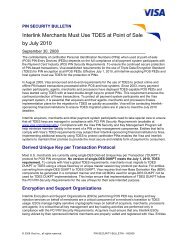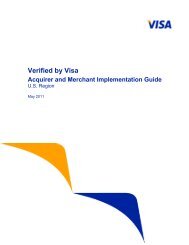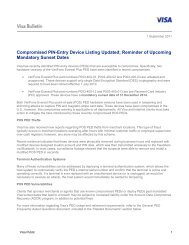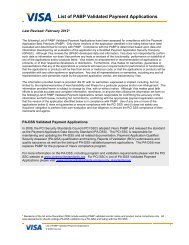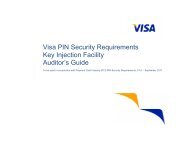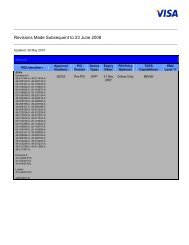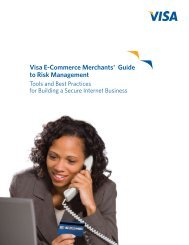Issuer PIN Security Guidelines - Visa
Issuer PIN Security Guidelines - Visa
Issuer PIN Security Guidelines - Visa
Create successful ePaper yourself
Turn your PDF publications into a flip-book with our unique Google optimized e-Paper software.
General <strong>PIN</strong><br />
Management<br />
<strong>Guidelines</strong><br />
The following guidelines apply to all aspects of the <strong>PIN</strong> management system .<br />
<strong>Issuer</strong>s should:<br />
• Ensure that any exposed data or credentials required for <strong>PIN</strong> management do<br />
not permit personalization of undetectable, unauthorized cardholder payment<br />
devices that can be used to make any payment with or without <strong>PIN</strong> as a<br />
CVM .<br />
For example when ICC or magnetic stripe data is processed it is vulnerable to<br />
the following:<br />
– Processed chip data (track 2 equivalent data without a distinguishing<br />
chip CVC/iCVV) can be used to create a magnetic stripe card clone .<br />
If the <strong>PIN</strong> is also available the clone may be used, undetected by the<br />
issuer host systems, for example at an ATM that does not accept ICCs .<br />
– Processed chip data can be used to create a ICC (without secret issuer<br />
keys) . Transaction routing to a third party stand-in provider may result<br />
in transaction authorization if stand-in does not share issuer keys .<br />
– Processed chip data or magnetic stripe data can be used to generate<br />
CNP credentials .<br />
– Processed magnetic stripe data can be used to create a magnetic<br />
stripe card clone . If the <strong>PIN</strong> is also available the clone may be used,<br />
undetected by the issuer host systems, at an ATM .<br />
• Confirm that the security checks performed on transaction data by their<br />
authorization host will detect when a transaction is from an unauthorized<br />
cardholder payment device for example:<br />
– The application should detect when a HSM fails to verify a chip card<br />
verification code that is provided during a magnetic stripe transaction .<br />
– <strong>Issuer</strong>s should verify the presence of the magnetic stripe during<br />
magnetic stripe transactions by using the card verification code, i .e . not<br />
solely rely upon the verification of the online <strong>PIN</strong> and correctness of the<br />
PAN .<br />
– <strong>Issuer</strong>s should decline ATM and POS cash back transactions which<br />
result in a card verification code failure .<br />
– <strong>Issuer</strong>s should validate all of the key information contained in the<br />
authorization request . These elements may include cardholder name,<br />
expiration date, <strong>PIN</strong> verification data and other discretionary data<br />
elements .<br />
– <strong>Issuer</strong>s should review and update velocity monitoring and neural<br />
network parameters for <strong>PIN</strong> transactions for example:<br />
- Excessive <strong>PIN</strong> attempts<br />
- Excessive <strong>PIN</strong> transactions<br />
- Excessive cashback or quasi-cash transactions<br />
- Separate daily/multi-day quasi-cash velocity parameters<br />
- Separate daily/multi-day cashback velocity parameters<br />
- High-risk countries<br />
<strong>Issuer</strong> <strong>PIN</strong> <strong>Security</strong> <strong>Guidelines</strong> 5<br />
<strong>Visa</strong> Public © 2010 <strong>Visa</strong>. All Rights Reserved.






